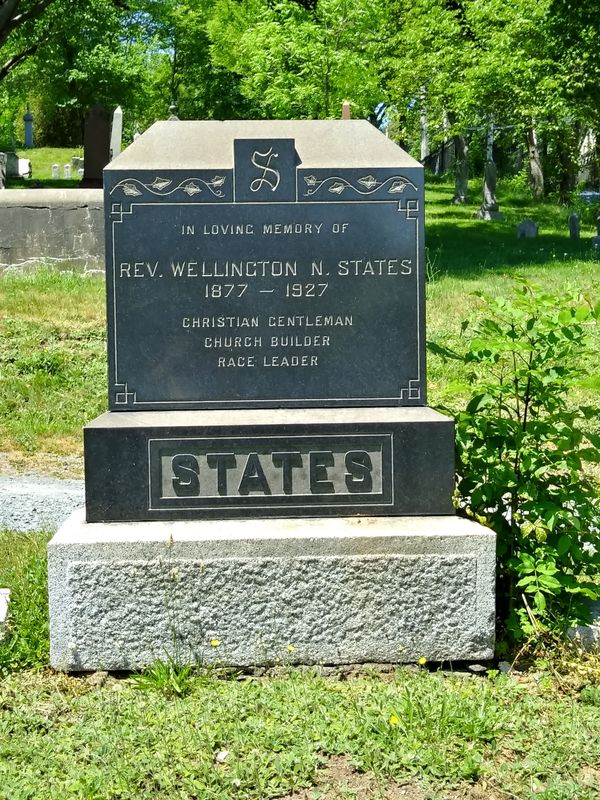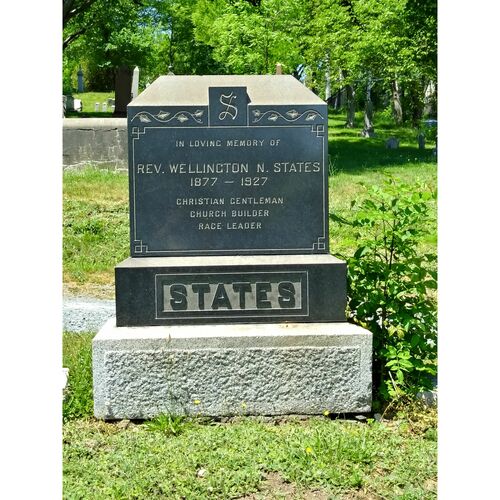
Source: Link
STATES, WELLINGTON NEY, Baptist clergyman; b. 1 Oct. 1874 in Wolfville, N.S., son of Joab States and Mary Eliza McCulla; m. 4 Dec. 1907 Muriel Viola States in Avonport, N.S., and they had three sons and two daughters; d. 3 May 1927 in Dartmouth, N.S.
W. N. States’s paternal ancestor was a freeborn African American refugee from New York who made his way to Saint John in 1783 and later settled in Parrsboro, N.S., which had a large population of black slaves. States’s engaging forenames suggest that his great-grandfather McCulla may have been one of the several Waterloo veterans who settled in Nova Scotia after the end of the Napoleonic Wars in 1815. The youngest child of an interracial marriage, States suffered the loss of both his Anglican mother (in 1880) and his Baptist father (in 1887). Family tradition has it that he was ill-used by his white maternal grandparents, with whom he went to live after his father’s death. The following year, aged 14, he ran away to sea. By 1891 States was a student at Horton Academy in Wolfville, the preparatory school for Acadia University. Leaving the academy in 1895, he went to Annapolis Royal as factotum to the pastor of the local Baptist church, Gilbert James Coulter White, who baptized him and became his mentor. States returned to Horton in 1897, perhaps with a view to university matriculation. He did not attend Acadia, however, but moved on to Halifax, where he joined the African Baptist church on Cornwallis Street and made the acquaintance of lawyer James Robinson Johnston*. They would remain intimate friends until Johnston’s murder in 1915.
In 1898 States received a licence to preach from the African Baptist Association. His original intention was to become a foreign missionary but, as this field was an exclusively white preserve, he was sent instead as a home missionary to the pastorless ABA churches of Granville Ferry and Inglewood (near Bridgetown) in Annapolis County. Then in April 1899 States, quite without authorization, took a daring and unilateral step which would render his ministry unique – he became the first black licentiate to be ordained in the Baptist Convention of the Maritime Provinces. For the entire 28 years of his ministry he would be not an African Baptist clergyman but a convention Baptist clergyman who happened to be black and who therefore served only black congregations.
Though the ABA’s 1899 annual meeting passed a motion of censure over States’s “irregular” ordination, any lingering concerns were soon dispelled by his outstanding personal qualities. Intelligent, articulate, personable, better-educated than most of the indigenous black Baptist clergy, and (in historian Robin W. Winks’s words) “inordinately handsome,” States could not fail to command attention. In August 1902 his standing was confirmed by his election as moderator and his appointment as field missionary, or “evangelist,” of the ABA. He would continue to itinerate after he acquired the first of his two major settled pastorates, Second Baptist in New Glasgow, in 1906. No sooner had he taken over Second Baptist than he brought it into the Nova Scotia Eastern Association of the United Baptist Convention of the Maritime Provinces. Throughout his 13 years in New Glasgow, States was between two worlds. New Glasgow was the only town in the industrial heartland of Pictou County where black people were allowed to reside.
States, like the long-serving clerk of the ABA, Peter Evander McKerrow*, was an integrationist, not a separatist. The Eastern Association was the only racially integrated association within the convention. But its liberalism did not mean that the local churches were integrated. Indeed, Second Baptist came into existence in 1903 because black people were not welcome at First Baptist. Though States’s views were in the minority among blacks, Second Baptist did not affiliate with the ABA until after he had left the congregation in 1919. By that time the church was part of the Northern Association of the convention, the Eastern Association having divided in 1915.
States’s friendship with James R. Johnston, clerk of the ABA in succession to McKerrow, meant that he quickly rose to the top of the association despite being a convention minister. He was three times moderator, in 1902–3, 1914–15, and 1923–24. The devastating loss of Johnston, the black community’s paramount leader, during States’s second term, was followed by the emergence of a triumvirate consisting of States, the Reverend William Andrew White*, and James Alexander Ross Kinney*, Johnston’s successor as clerk, which guided the African Nova Scotian community in the interwar years. If Johnston’s murder hastened the descent “to the nadir” (as Winks describes the period), ironically the 65th annual meeting of the ABA in Halifax in September 1918 was States’s finest hour. In a move that he supported the meeting, which was formally opened by the lieutenant governor, resolved to seek statutory incorporation for the ABA (achieved in 1919 as the African United Baptist Association), and States was nominated vice-moderator. During the meeting he reported the formation of a ministerial union, the purpose of which was “to organize the Pastors and Licentiates for more effective efforts, morally, socially and spiritually.” He was elected its first president.
Mildly tubercular, States had been prevented in 1917 from going overseas as chaplain of the No.2 Construction Battalion of the Canadian Expeditionary Force (the Black Battalion). It was a crushing blow, since his friendly rival W. A. White went in his place. In 1919, driven from Second Baptist, New Glasgow, by the congregation’s inability to pay his salary, States assumed his final pastorate, Victoria Road in Dartmouth, a venerable but also impoverished AUBA church. By 1926 States had, in White’s words, “been laid aside, perhaps permanently, by illness.” In the spring of 1927, his 53rd year, he succumbed to pneumonia. His widow, who was known to family and friends as Myrtle and who for 30 years was the organizer of the ladies’s auxiliary of the AUBA, survived him by 57 years.
W. N. States was the most outstanding African Nova Scotian clergyman of his generation. Quite literally a builder of churches (he was a carpenter), he was also a builder of the African Baptist community. As field missionary, interim pastor, settled pastor, and officer and life member of the AUBA, he served the association not only by leading it in many capacities but also by ministering, at one time or another, to nearly all of its constituent churches. Yet his longest and most productive pastorate was with a newly established congregation which he purposely kept out of the AUBA. For States the church was more Baptist than black, and the needs and interests of the black community were not necessarily best served by an ethnic church association. He strove to preserve the legacy of his friend Johnston, especially in regard to the proposed educational institute which after Johnston’s death became the Nova Scotia Home for Colored Children. His own true successor was a fellow native of Wolfville, the Reverend Dr William Pearly Oliver*, who in 1960 became the first AUBA clergyman to be elected president of the white convention.
[Wellington Ney States was the compiler of Hymns sung at the services of Rev. W. N. States, evangelist of the African Baptist Association of Nova Scotia, 1903 (Halifax, 1903; reprinted as “Hymns sung at the services (1903)” in vol.1 of Fire on the water, infra, 92–96). States’s official history of the African Baptist Association, commissioned in 1917, remained unwritten or unfinished, and the history of the ABA has yet to be written. States’s few extant papers, including his invaluable commonplace book, are held by his granddaughter, Sherrolyn M. Riley; they form the basis of this article. The only comprehensive secondary source is M. L. Knight, “Wellington Ney States, 1877–1927: life and work with the African United Baptist churches” (m.ed. thesis, St Mary’s Univ., Halifax, 1983). The author is grateful to historical demographer David W. States for helping to reconstitute the Reverend States’s branch of the extended States family. b.c.]
Baptist Hist. Coll., Acadia Univ. (Wolfville, N.S.), Horton Collegiate Academy, student records, 1879–1910. “The life of Rev. W. N. States,” Clarion (New Glasgow, N.S.), 6 Sept. 1947. African Baptist Assoc. of N.S., Minutes (Halifax), 1898–1929. Fannie Allison et al, Traditional lifetime stories: a collection of black memories (2v., Dartmouth, N.S., 1987–90). The Baptist year book of the Maritime provinces of Canada . . . (Halifax, etc.), 1898–1905. Fire on the water: an anthology of black Nova Scotian writing, ed. G. E. Clarke (2v., Porter’s Lake, N.S., 1991–92). A. P. Oliver, A brief history of the colored Baptists of Nova Scotia, 1782–1953 ([Halifax, 1953]). Donald Thomas, These fifty years with the Second United Baptist Church (New Glasgow, 1953). United Baptist year book (Saint John), 1906–29. R. W. Winks, The blacks in Canada: a history (2nd ed., Montreal and Kingston, Ont., 1997).
Cite This Article
Barry Cahill, “STATES, WELLINGTON NEY,” in Dictionary of Canadian Biography, vol. 15, University of Toronto/Université Laval, 2003–, accessed January 1, 2026, https://www.biographi.ca/en/bio/states_wellington_ney_15E.html.
The citation above shows the format for footnotes and endnotes according to the Chicago manual of style (16th edition). Information to be used in other citation formats:
| Permalink: | https://www.biographi.ca/en/bio/states_wellington_ney_15E.html |
| Author of Article: | Barry Cahill |
| Title of Article: | STATES, WELLINGTON NEY |
| Publication Name: | Dictionary of Canadian Biography, vol. 15 |
| Publisher: | University of Toronto/Université Laval |
| Year of publication: | 2005 |
| Year of revision: | 2005 |
| Access Date: | January 1, 2026 |



